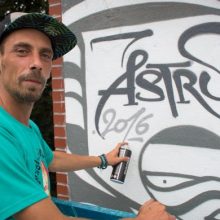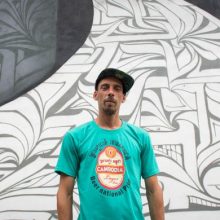Source: en.iranwire.com
By Sean Nevins
Taking her normal route to a lunch spot on Frederick Douglass Boulevard in Central Harlem on a hot summer day, Randi, 45, looked across the street and saw something she would describe as amazing.
It had just sprouted up in the last 24 hours. Crossing the street, she shouted with excitement, “We need more of this, we need more art!”
Wearing a faded bandana on her head and black sunglasses, Randi looked again. The image took up the entire side of a four-storey apartment building, was a black and white mural painted by French street artist Astro, 45. The imposing mural, reminiscent of Victor Vasarely, the founder of the Op Art movement, depicts what looks to be a doorway or gate leading through a dark passageway, and out into light. The illustration is covered in a graffiti-style design of eyes and shapes that are almost animal-like. The composition is so life-like that it looks as if one could walk right into it.
The Not A Crime street art campaign commissioned French artist Astro to take part in an initiative aimed at bringing attention to human rights violations against Baha’is in Iran. Baha’is suffer from various forms of discrimination, from not being allowed to study at or attend university to their homes being torched to their businesses being confiscated to arbitrary arrests. The campaign works with Street Art Anarchy, a New York-based startup, which is curating the project. They plan to put up 15 murals all over Harlem throughout the summer ahead of the United Nations General Assembly conference in September. Astro’s piece is the seventh installment of this project. Other artists involved in the project include Ricky Lee Gordon, Franco the Great, Rone, Alexandre Keto, OverUnder, and Elle.
Talking abut the mural, Astro said, “I represented the door of the university in Iran,” While he talked, he stood under a blue hydraulic lift while rain clouds emptied out above. The doorway in Astro’s mural is in the exact shape of the famous twin gates in front of the University of Tehran – as well-known in Iran as the dome of Columbia University’s library or the spires of Oxford are in the US and Europe. Astro told IranWire that he tried to replicate the design of the gate as his call for Baha’is to be given access to education. “It’s special architecture. It’s like an arch, and here I do the same architecture with my style. I do the way, the tunnel,” he said. “The lights at the end of the tunnel — it’s the education and the light.” The original university gates, designed by Korosh Farzami in 1965, are supposed to evoke the image of two birds taking flight into the heaven of prosperity, success and knowledge.
“Education is very important for everyone in the world,” said Astro, who also said he was proud to be part of the campaign and its aims and beliefs.
The Baha’is are the largest religious minority in Iran. Although Iran’s last shah and previous rulers before him discriminated against the community, systematic discrimination began in earnest following the revolution in 1979. Hundreds of Baha’is were killed, tortured and imprisoned. According to the Baha’i International Community, “thousands lost jobs, access to education, and other rights – all solely because of their religious belief,” reports the Baha’i International Community. The government even issued an official directive to expel Baha’i students from universities. The community responded to this aggression by creating their own underground university in 1987, the Baha’i Institute of Higher Education (BIHE), which is the subject of To Light a Candle, a documentary created by Not A Crime founder and IranWire editor-in-chief Maziar Bahari.
When she heard why the mural was created, Randi told IranWire, “You can’t be locking people up for wanting to learn. I mean that’s the ultimate form of oppression and control.”
Bobby, 28, a dental student at Columbia University, stopped and peered through the chainlink fence separating the wall from the street. He said he appreciated the message. “It’s not only benefitting the local Harlem community, but to also have a political message associated with it brings a worldwide awareness.”
Ultimately, however, it was the painting’s beauty that stopped people in their tracks.
“I was just thinking that the revival of art is happening in Harlem and it’s nice to walk around and see beauty, something other than brick,” said Wenimo, 28, who mentioned that she had just noticed two other murals on 126th Street and Adam Clayton Powell Jr. Boulevard, both also commissioned by Not A Crime.
Putting her hands on her hips and squinting up to look at Astro’s piece, she said, “ It kind of makes me think about hope ‘cause the whole light at the end of the tunnel thing, and it’s bright. I feel like I’m looking into something dark and then I see brightness on the other side of it.”
Muhammad, 17, who got off his skateboard to look more closely at the piece, focused on the painting’s many semi-hidden eyes. “They might represent that maybe God is watching, and if you do good you might be able to end up where the light is at,” he said.
Not A Crime will commission eight more murals throughout Harlem this summer from artists from around the world.
Related Articles:
New Murals and New Friends: Not a Crime Launches in Harlem
Harlem Monuments Spread the Word about Bahai’s in Iran
“Education is your shield and trophy”



Leave a Reply